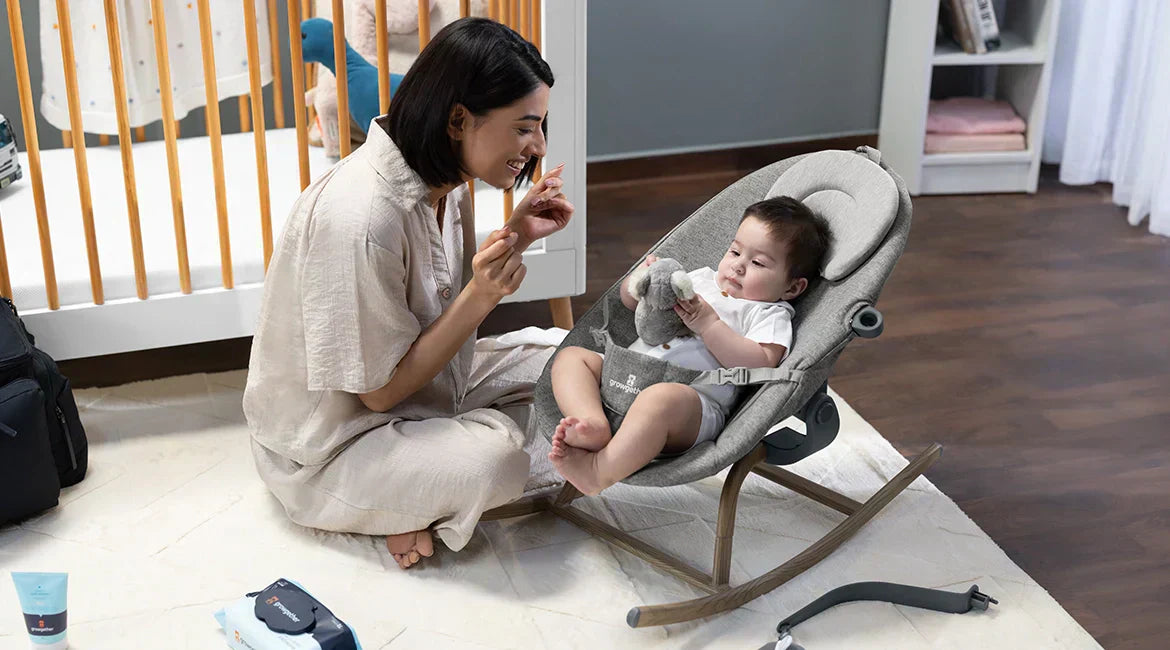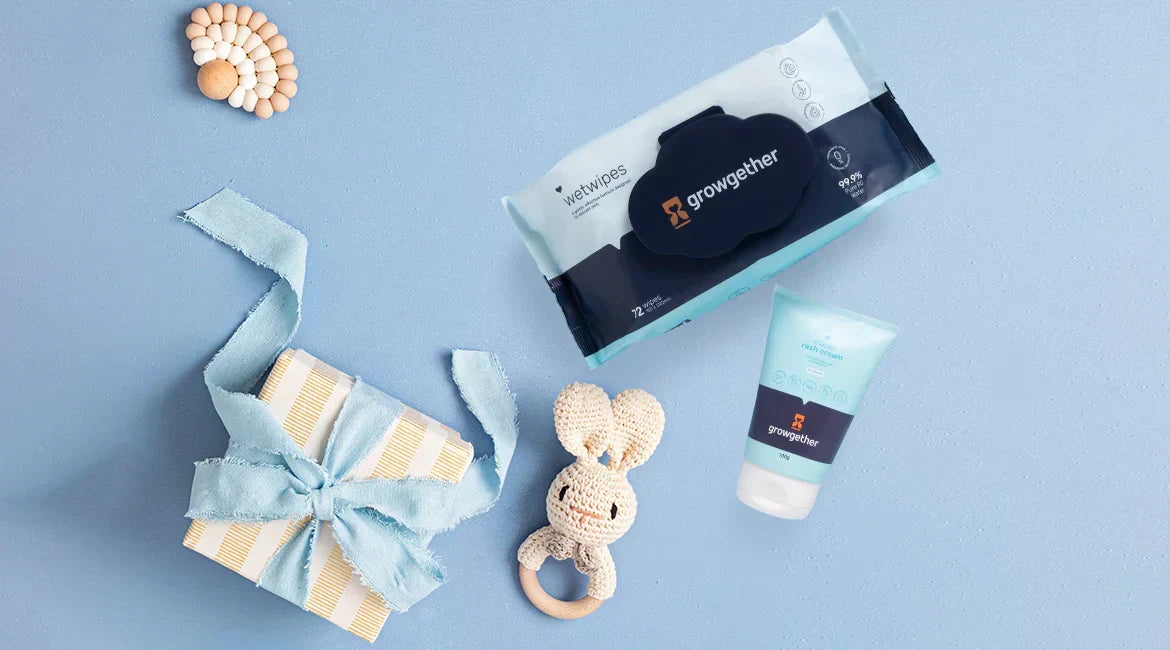How to Treat Diaper Rash in Newborn Fast
Table of content
- Why Is My Baby’s Skin Red and Sore?
- What Is Diaper Rash?
- Why Does Diaper Rash Happen?
- How Common Is Diaper Rash in India?
- 10 Quick Tips to Treat Diaper Rash Fast
- Try Growgether Diaper Rash Cream for Fast Results
- Listen to our Customer Priya’s Story
- Pro Tips for Busy Indian Parents
- When Should You See a Doctor for Your Baby’s Skin Rashes?
Why Is My Baby’s Skin Red and Sore?
If your baby’s bottom is red, sore, or crying every time you change the diaper, your baby is dealing with diaper rash. It’s a common problem that causes discomfort in your little one.
You might be questioning, “Why is this happening?” and “How do I stop it fast?” We understand that as a parent, it’s painful to see your newborn upset. The good news is that with these simple steps you can do at home, diaper rash can heal quickly.
What Is Diaper Rash?
Diaper rash is redness and irritation on the baby’s skin in the diaper area — this includes the buttocks, thighs, and genital area. The skin may look red, feel warm, and sometimes become raw or even blistered.
Diaper rash happens because the skin there is very delicate and sensitive. When wetness, friction, or irritants like urine or stool stay on the skin too long, they can cause this painful rash.
Why it matters:
A baby’s bottom feels hurt with a rash, so they cry when you change the diaper. If untreated, the rash can get worse and even cause infections.
Why Does Diaper Rash Happen?
Prolonged Exposure to Wetness and Stool
Babies’ skin is soft and thin. Urine and stool contain harmful chemicals that can irritate the skin. When diapers aren’t changed quickly, the skin stays wet and soggy. This moist environment makes the skin break down more easily and get inflamed.
Friction from Diapers
Tight diapers or clothing can rub against the baby's skin, particularly when they are wet. This rubbing causes friction that makes the skin raw and painful.
Using Harsh Wipes or Soaps
Some baby wipes or soaps contain alcohol, fragrance, or chemicals that can irritate sensitive skin. These make the rash worse rather than helping.
Diarrhea or Loose Stools
When a baby has diarrhea, the stool is more acidic and watery. It irritates the skin faster and makes diaper rash more common and severe.
New Foods or Allergies
Introducing solid foods or certain formula types can sometimes change the stool’s consistency or cause mild allergies, leading to diaper rash.
How Common Is Diaper Rash in India?
- According to research, between 4% to 35% of Indian babies get diaper rash before they turn two years old.
- A survey revealed that over two-thirds (67.3%) of babies had experienced diaper rash at least once.
- During diarrheal illness, the chance of diaper rash goes up by 3 times, making this a common concern for many Indian parents.
This shows that nappy rash is very common, but with care, it can be treated quickly at home.
10 Quick Tips to Treat Diaper Rash Fast
Here are detailed, easy-to-follow tips to heal your baby’s diaper rash quickly:
Tip 1: Air Time for the Skin
Why? Air helps dry out the skin and stop irritation caused by wet diapers.
How to do it:
- After removing the diaper, place your baby on a clean towel in a warm, safe place.
- Keep the diaper off for about 10 minutes. If possible, do this two or three times a day.
- This gives the skin a chance to breathe and recover.
Extra note: In India’s warm climate, air time is especially helpful. Just be sure your baby is comfortable and not getting cold.
Tip 2: Gentle Cleansing After Every Change
Why? Cleaning removes urine and stool, which cause irritation.
How to do it:
- Use lukewarm water with cotton balls or a soft cloth instead of harsh wipes.
- Avoid using soap, alcohol, or scented wipes, as they can dry out or irritate the skin.
- After cleaning, softly pat the area dry rather than rubbing it.
Remember: Keeping the skin clean and dry is key to healing.
Tip 3: Apply a Barrier Cream
Why? Barrier creams keep the skin safe from wetness and things that can irritate it.
What to use:
- Creams with zinc oxide or petrolatum create a waterproof layer.
- After each diaper change, apply a thin layer to clean, dry skin.
Important: Don’t use too much cream; just a thin layer is enough to protect without clogging pores.
Tip 4: Use Super-Absorbent Diapers
Why? High-quality diapers keep moisture away from the baby’s skin.
How to choose:
- Choose diapers labeled as “ultra-absorbent” or “overnight.”
- Change diapers every 2 to 3 hours to prevent moisture buildup.
Tip 5: Change Diapers More Often During Diarrhea
Why? Diarrhea stools are acidic and increase rash risk on baby’s soft skin.
Action:
- Change diapers immediately after loose stools to prevent irritation.
- Thoroughly wash the area with water and gently pat it dry before applying barrier cream.
Tip 6: Choose Fragrance-Free Wipes
Why? Fragrances and alcohol often irritate sensitive skin.
What to do:
- Choose wipes that are labeled “fragrance-free,” “alcohol-free,” or made for “sensitive skin.”
- Or simply use plain water and cotton balls.
Order 72 Alcohol & Fragrance-Free Wet Wipes at ₹299.
Tip 7: Dress Your Baby in Loose Clothing
Why? Tight clothes trap heat and moisture, worsening the rash.
How:
- Use loose cotton clothes or diapers with soft, stretchy waistbands.
- Avoid tight pants or plastic covers that do not breathe.
Tip 8: Try Natural Remedies
Why? Some natural products have soothing and antibacterial effects.
Options:
- Coconut oil: Common in Indian homes, it helps moisturize and protect skin. Apply gently.
- Breastmilk: Contains natural healing properties; Apply a few drops on the rash and let it air dry.
Note: Always do a patch test first to check for any allergic reaction.
Tip 9: Keep an Eye on Food Introductions
Why? New foods can affect stool and skin sensitivity.
How:
- Introduce new foods one at a time, especially after 6 months.
- Watch for any new rash or diarrhea that appears after certain foods.
Tip 10: Know When to Call the Doctor
Signs to watch for:
- Rash not improving after 3 days of home treatment.
- Rash with pus, blisters, bleeding, or swelling.
- Baby has fever, is unusually sleepy, or refuses to feed.
In these cases, infection may have set in and needs medical care.

Try Growgether Diaper Rash Cream for Fast Results
Growgether is specially made for newborn and toddler skin. It’s:
- Gentle and safe from day one.
- Contains zinc oxide that forms a strong barrier to protect skin.
- Non-sticky and easy to apply — so changes are quick and clean.
- Hypoallergenic and dermatologically tested, so it won’t cause more irritation.
Buying info:
Available in 100 g tubes, shipped across India for ₹49, free shipping over ₹499. Delivery in 3–7 days.
This cream is a trusted partner for Indian parents who want fast, safe relief for their baby’s rash.
Order Growgether’s Diaper Rash Cream for Your Newborn Baby!
Listen to our Customer Priya’s Story
Priya is a new mom from Delhi. She saw that her baby Aarav’s skin was red and hurting. Changing diapers was hard for him, and he cried a lot. Like many of our customers, Priya gave Aarav some air time, used soft wipes, and put on Growgether cream. After three days, Aarav’s rash improved, and he felt good again. Priya says that using a cream without strong chemicals and keeping the skin clean and dry helped her baby.
Pro Tips for Busy Indian Parents
- Set phone reminders to change diapers on time.
- Keep all diaper-changing supplies ready in one place for quick access.
- Ask grandparents or helpers to give the baby air time or apply cream.
- Use breathable cotton cloth nappies if disposable ones irritate.
Order Your Diaper Bag – Keep All Changing Supplies Handy in One Place!
When Should You See a Doctor for Your Baby’s Skin Rashes?
If the rash:
- Lasts over 3 days even with home care.
- Looks infected (blisters, pus, bleeding).
- Causes fever or irritability.
Early treatment by a doctor prevents serious infections.
Summary
Diaper rash can be painful, but it is treatable with simple, everyday steps:
- Keep your baby’s skin dry and clean.
- Give regular airtime.
- Use gentle wipes and good barrier creams like Growgether.
- Change diapers often, especially during diarrhea.
- Dress your baby comfortably.
Following these steps helps your baby’s skin heal fast and keeps them happy.





